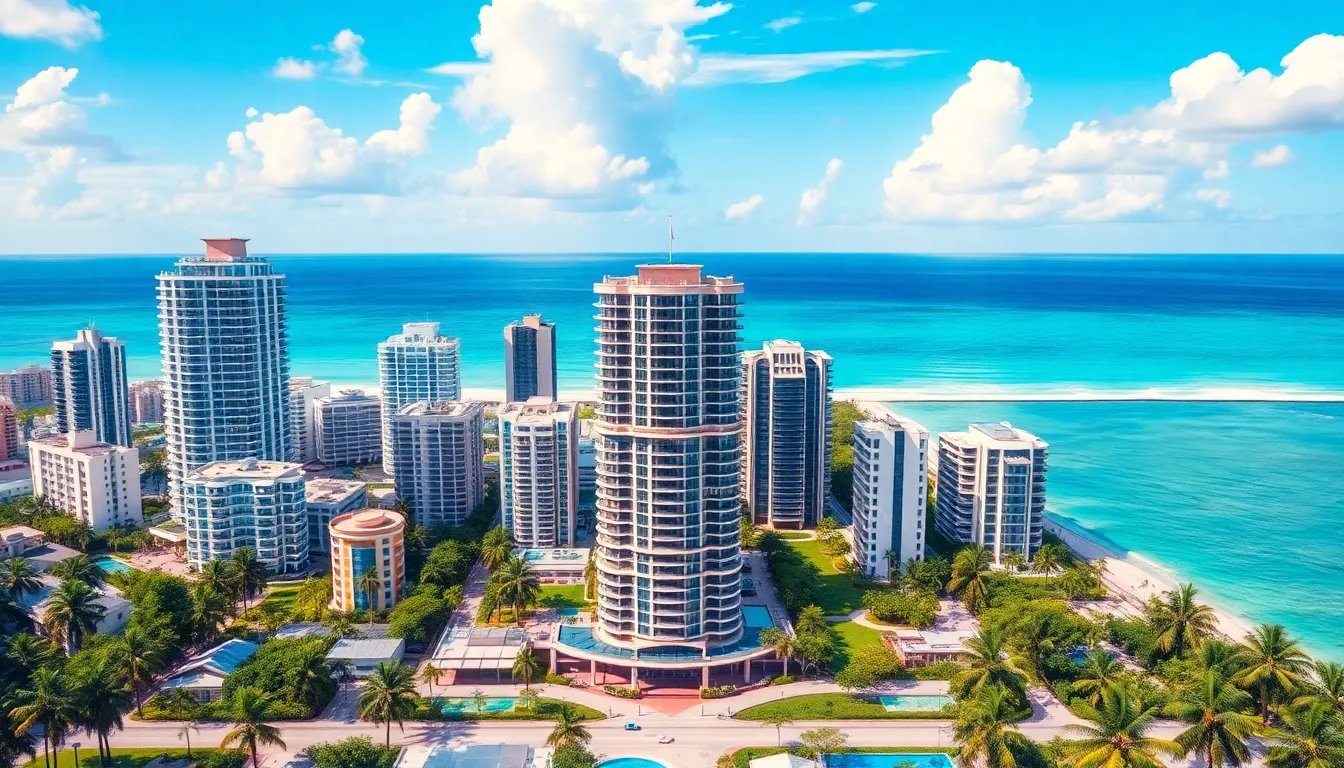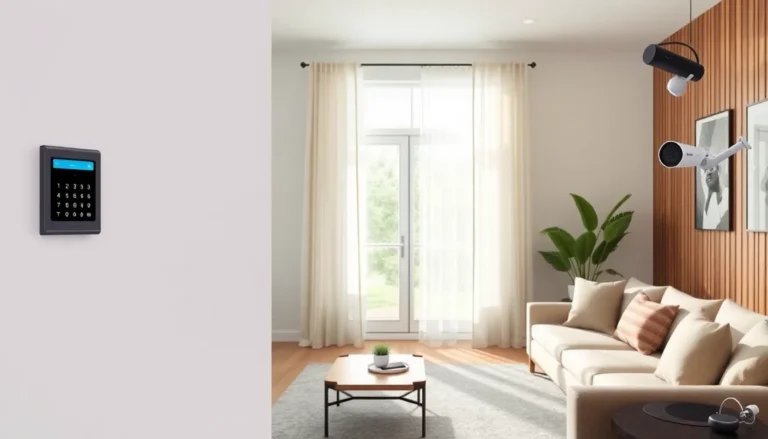Miami’s real estate market is hotter than a summer day on South Beach. With its stunning ocean views and vibrant culture, it’s no wonder everyone wants a slice of this tropical paradise. But what’s really happening in the Miami housing scene?
Table of Contents
ToggleOverview of Miami Real Estate Trends
Miami’s real estate market continues to experience significant growth, driven by high demand and limited inventory. Recent data indicates a surge in the average home prices, with a year-over-year increase of approximately 15%. Such increases attract both local and out-of-state buyers.
Condos remain particularly popular among investors. Choices range from luxury waterfront properties to more affordable options in up-and-coming neighborhoods. The average condo price in Miami has risen to around $400,000, illustrating strong interest in this segment.
New developments play a crucial role in shaping the landscape. Notable projects include mixed-use buildings that combine residential, retail, and hospitality spaces. These developments cater to the growing trend of urban living, appealing to young professionals and families alike.
Short-term rentals have also gained traction, with platforms like Airbnb making it easy for property owners to generate additional income. Regulations surrounding these rentals are evolving, prompting owners to stay informed.
The influence of remote work continues to reshape buyer preferences. Many are opting for larger homes with dedicated office spaces, prioritizing comfort alongside location. Neighborhoods like Coconut Grove and Coral Gables are seeing increased interest due to their residential appeal and proximity to amenities.
Sustainability is another trend for buyers. Energy-efficient homes, solar panels, and smart technology are in demand. Developers incorporate eco-friendly features, aligning with the values of today’s environmentally-conscious buyers.
Market forecasts suggest continued appreciation in property values, driven by Miami’s allure as both a lifestyle destination and a business hub. Overall, current trends reflect a dynamic real estate environment where innovation and adaptability remain essential.
Current Market Conditions

Miami’s real estate market exhibits vibrant dynamics influenced by numerous factors. Significant price escalations characterize the current landscape, reflecting increased demand.
Price Trends
Average home prices in Miami have surged by approximately 15% year-over-year. Condos capture investor interest, with prices averaging around $400,000. Luxury properties drive demand as affluent buyers seek oceanfront views and upscale amenities. The competitive nature of the market prompts bidding wars, often leading to properties sold above asking prices. Forecasts suggest that appreciation in property values will continue, reinforcing Miami’s appeal as a premier destination for both living and investment. Trends indicate that sustainable and energy-efficient homes now command higher prices due to increasing buyer preference.
Inventory Levels
Inventory levels in Miami remain critically low, creating a heightened sales environment. The number of available homes hasn’t kept pace with buyer demand, resulting in a tight market. Active listings have decreased significantly, prompting urgency among prospective homeowners. Mixed-use developments play a crucial role, bringing new units to market while addressing the demand for urban living. Regulatory changes impact short-term rental availability, further influencing inventory dynamics. As new construction strives to meet demand, investors eye opportunities in emerging neighborhoods.
Key Drivers of the Market
Several factors significantly influence the Miami real estate market. Understanding these drivers provides insight into the ongoing trends and dynamics shaping the local housing landscape.
Economic Factors
Strong economic growth propels the Miami real estate market. Job opportunities in industries like technology, healthcare, and tourism attract many new residents. Additionally, Miami’s status as a global business hub enhances demand for both residential and commercial properties. The recent average home price increase of about 15% year-over-year illustrates how economic conditions affect housing costs. Low interest rates further stimulate buyer activity, encouraging more individuals to invest in properties. Economic stability attracts affluent buyers, particularly in the luxury segment, where demand for oceanfront properties continues to create intense competition.
Demographic Changes
Demographic shifts play a crucial role in Miami’s real estate trends. An influx of millennials and Generation Z buyers drives demand for urban living spaces, such as condos in trendy neighborhoods. Many prefer larger homes that accommodate remote work needs, prompting shifts in property requirements. Growing diversity among residents leads to varied preferences in property types and locations. Additionally, retirees seek vibrant communities offering a mix of leisure and culture, which bolsters demand in specific markets. As the population ages and changes, the real estate landscape evolves to meet these shifting demographics.
Popular Neighborhoods in Miami
Miami features diverse neighborhoods that cater to various lifestyles and preferences. Popular options include emerging areas and established hotspots.
Emerging Areas
Coconut Grove attracts attention with its lush greenery and Bohemian vibe. Homes in this neighborhood typically appeal to those seeking artistic surroundings. Meanwhile, areas like Overtown experience revitalization, transforming into exciting cultural hubs. Property values in Overtown have risen by approximately 10% over the past year, reflecting growing interest. Buyers find that newer developments offer modern amenities while embracing local history. The continued investment in infrastructure here bolsters market confidence, making these areas increasingly desirable.
Established Hotspots
Coral Gables remains a classic choice for many professionals and families. Many are drawn to its Mediterranean architecture and proximity to top-rated schools. Waterfront properties here command premium prices, often above the asking price. South Beach, known for its vibrant nightlife and stunning ocean views, attracts buyers looking for luxury condos. Properties in this dynamic neighborhood average around $600,000. Buyers appreciate the combination of lifestyle and investment potential. Wynwood also stands out, celebrated for its art scene and trendy atmosphere, making it a favorite among millennials and young professionals.
Future Predictions
Miami’s real estate future looks dynamic, with trends reflecting changes in buyer preferences and market conditions. Stakeholders focus on upcoming trends shaping this vibrant locale.
Short-Term Outlook
Current high demand is expected to persist, particularly in luxury segments. Inventory constraints likely lead to continued price increases, possibly around 10% this year. Short-term rentals will maintain popularity, influenced by the travel rebound. Buyers prioritize properties in thriving neighborhoods like Coral Gables and Coconut Grove, enhancing the competitive landscape. Platforms such as Airbnb will drive further demand, while legislative shifts in short-term rental regulations will continue impacting market conditions.
Long-Term Projections
Over the next few years, property values are projected to appreciate steadily, primarily due to demographic shifts. An influx of millennials and Generation Z is anticipated to reshape buyer preferences, favoring larger homes with office spaces. Additionally, sustainability initiatives will drive demand for energy-efficient homes. As Miami solidifies its status as a lifestyle destination, growing interest from national and international buyers will likely bolster market conditions. Long-term economic growth and job creation in sectors like technology and healthcare will further enhance real estate opportunities.
Miami’s real estate market stands at a pivotal moment marked by strong demand and limited inventory. As buyers increasingly seek larger homes and eco-friendly features, the landscape continues to evolve. Neighborhoods like Coconut Grove and Coral Gables are gaining traction, appealing to diverse demographics and lifestyles.
With luxury properties and short-term rentals driving significant interest, the market is poised for continued growth. Ongoing economic expansion and demographic shifts will likely maintain upward pressure on property values. As Miami solidifies its reputation as a vibrant lifestyle destination, real estate opportunities will remain abundant for those ready to navigate this dynamic environment.



